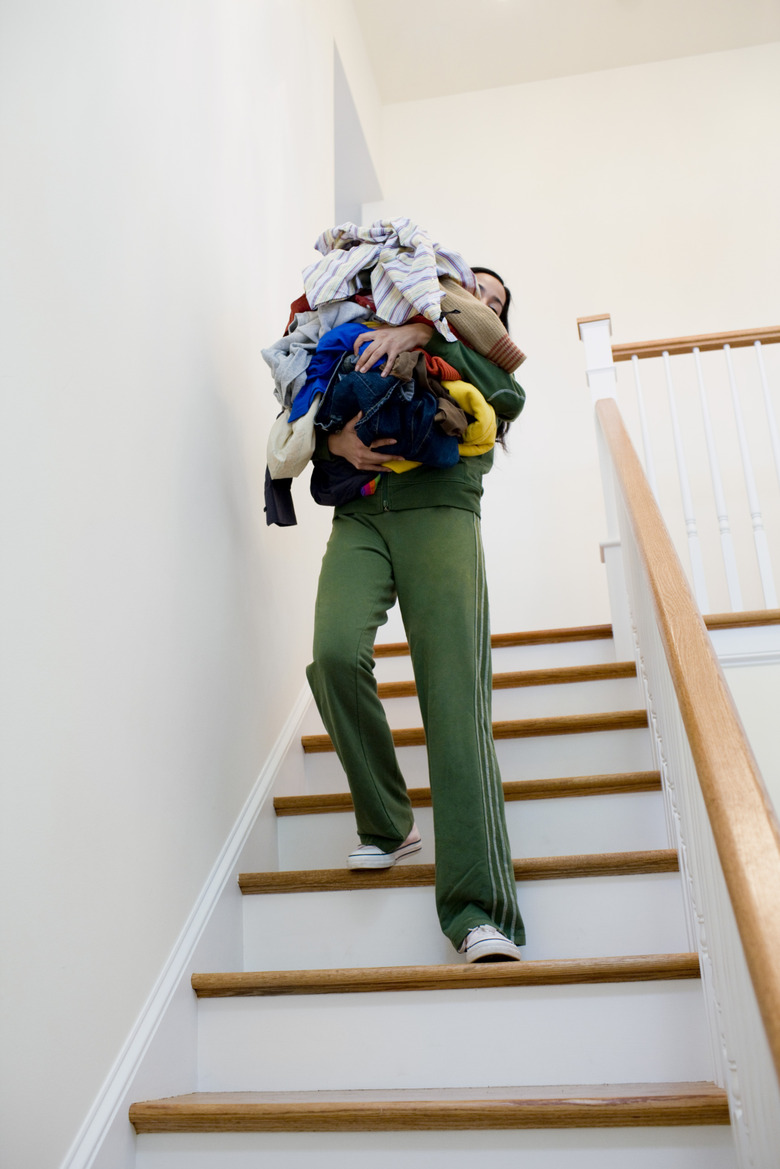Making Stair Treads Deeper
Things Needed
-
Chisel
-
Hammer
-
Measuring tape
-
Table saw
-
Boards for treads
-
Boards for risers
-
Construction adhesive
-
Caulk gun
-
2-inch nails
-
1-inch nails
-
Nail punch
Adding new treads to existing stair treads is a common remodeling technique. Municipal codes and the National Building Code (NBC) regulate the construction and renovation of stairs, so your new treads must meet those requirements. For a typical staircase, the stair tread must measure 8 1/4 inches to 9 inches deep, measure 1 inch thick or more and have a maximum 1 1/2-inch-deep nosing. The stair riser must measure 8 to 8 1/4 inches high. For stair treads less than 9 inches deep, secure a new, deeper tread directly on top of the existing tread. To prevent the new tread from protruding beyond the 1 1/2-inch nosing required by codes, secure a new riser to each existing riser, too.
Step 1
Chisel off the nosing of the existing treads so that each tread does not protrude beyond the riser board.
Step 2
Measure the existing treads and cut new boards for each tread. Include the nosing of the tread in your measurement. The nosing is not a separate piece of wood; it is the short extension of the tread that hangs over the riser. The nosing section of the tread should extend at least 1 to 1 1/2 inches over the riser.
Step 3
Spread construction adhesive evenly over the first stair tread.
Step 4
Place the new stair tread on the first tread. Drill three, evenly spaced pilot holes through the new tread and into the existing tread on the sides of the tread, approximately 1 inch away from the sides of the tread.
Step 5
Hammer 2-inch nails into the holes. Use the nail punch to tap the head of the nail slightly below the surface of the wood.
Step 6
Continue adding new treads to the existing treads until all the treads are covered.
Step 7
Measure the nosing depth of the new treads. If the depth is greater than 1 1/2 inches, you must add new risers to the staircase.
Step 8
Measure the height and width of the existing risers. Cut new boards for each new riser. Consider the thickness of the board you will need. For example, if the stair nosing protrudes to a thickness of 1 3/4 inches, use thin, 1/4-inch plywood or boards for the new risers.
Step 9
Spread construction glue evenly over the first riser.
Step 10
Place the new stair riser board on the first riser. Drill three, evenly spaced pilot holes through the new riser and into the existing riser on the sides of the riser, approximately 1 inch away from the sides of the riser.
Step 11
Hammer 2-inch nails into the holes. Use the nail punch to tap the head of the nail slightly below the surface of the wood.
Step 12
Continue adding new risers to the existing risers until all the risers are covered.
Tip
For best results, start replacing the treads at the top of the staircase. This will protect the new treads from damage from power tools and nails as you work your way down.
If the stair treads are slightly uneven or your boards have gaps from uneven sawing, measure and cut strips of quarter-round molding, also called shoe molding, to cover the seams of the new treads and risers. Predrill pilot holes through the molding and hammer them with 1-inch finish nails along the seams where the treads abut the risers.
Warning
Your local building codes may differ from the National Building Code regulations. Check with your local codes department for exact specifications and the possibility of obtaining a building permit for the work.
If your new stair treads will rise higher than 1/8 inch from the existing stair tread height, you may need to adjust the height of the lower and upper floors at each end of the staircase. For example, if your new stair treads measure a new thickness of 1/2 inch, install 1/2-inch flooring at the top and bottom of the staircase. This is common in renovation procedures when the entire flooring and staircase system is restored as one. Failure to elevate the flooring with the staircase may result in a codes violation or accidental injury.
Don't make stair treads deeper than 9 inches because the staircase may become difficult for people to climb and can increase their risk of falling.
